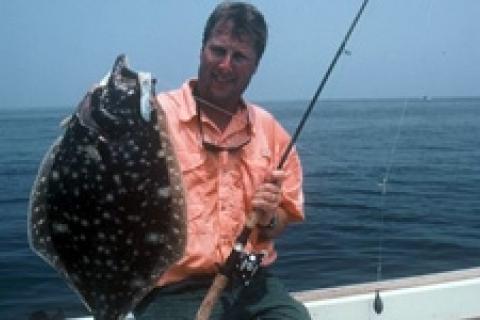
 Virginia and Maryland's Chesapeake Bay is famous for some exciting gamefish — red drum, black drum, cobia and striped bass to name a few. But one of the most appealing species to many anglers is the humble flounder.
Virginia and Maryland's Chesapeake Bay is famous for some exciting gamefish — red drum, black drum, cobia and striped bass to name a few. But one of the most appealing species to many anglers is the humble flounder.
I have to admit I've been a flounder addict practically all of my life. There's something special about this two-tone fish — brown on one side, white on the other — that has always appealed to me.
For one thing, contrary to their reputation, they are challenging to catch. It takes knowledge to know where to drift for them, skill at choosing the right bait and deftness in knowing just how long to wait before setting the hook.
Flounder also battle surprisingly well when hooked, considering their odd shape and bottom feeding status. And best of all, they are the most tasty fish in the Chesapeake when broiled, deep-fried in batter, or sauteed in lemon and butter.
These are a few of the reasons flounder are rapidly gaining popularity among Chesapeake Bay anglers. Another reason is that the populations are thriving, thanks to careful management.
A fish has to weigh 7 pounds to secure a citation as a trophy catch. That makes a nice amount of delicate white flounder fillets! Every year dozens of such fish are caught.
So how do you latch onto these brown and white fish? Start with the right bait. This can mean a live minnow (mummichogs are the favorite); a 3- to 7-inch strip cut in a long v-shape from another fish; a piece of squid; or finally, a small live spot.
All of these offerings are fished on bottom rigs with a sinker bouncing along the bay floor and the bait trailing anywhere from a few inches to a foot or so above it.
Drifting is without question the best tactic. The tide and wind combination can influence how good of a drift you get. Vary the weight according to how these two forces interact.
On a still tide, you'll mostly catch just crabs or sharks. But when conditions are just right, your bait will drift temptingly over the bottom behind the boat and soon you'll feel either a dull weight or perhaps a "pecking" sensation telegraphing up the line.
Don't set the hook at this point, and don't feed line. Instead, just drag the fish along behind the boat without moving your hand or the rod at all.
When you sense the fish has the offering securely in its mouth, set the hook by quickly reeling as you lift the rod upwards.
Where to go? The best bet in the entire bay is the area around the Chesapeake Bay Bridge Tunnel in the lower bay. Many spots along the span are good. Just look where the boats are concentrated then drift a polite distance away.
The "tubes" where the bridge turns into a tunnel and goes under water are hot spots for particularly large flounder. Fish right where the bottom comes up onto the "tube" and also where it drops off again on the opposite side.
Other good flounder locations include the Cell, Tangier Sound, and the mouths of feeder rivers leading into the bay such as the Potomac, Rappahannock, Wicomico and James. And while they're not part of the Chesapeake Bay, Wachapreague and Chincoteague inlets on the Eastern Shore are two other famous and reliable flounder spots. Action should continue strong through mid-October.
For more information on Chesapeake Bay flounder, contact the Virginia Saltwater Fishing Tournament, 968 S. Oriole Dr., Virginia Beach, Va., 23451, 757-491-5160.
- 7276 views

